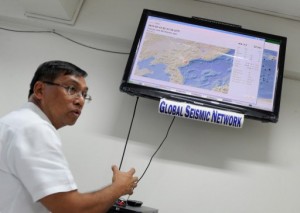MANILA, Philippines — “You don’t need to be near a fault to be affected by an earthquake.”
These were the words of Philippine Institute of Volcanology and Seismology chief Renato Solidum as he warned that Caloocan City could still suffer massive destruction and loss of life if an earthquake as powerful as the one that struck Bohol two weeks ago would hit Metro Manila, despite the city’s considerable distance away from the West Valley Fault.
Speaking at the first Caloocan Local Government Business Conference organized by the city government, Solidum said that around 3,100 of the 1.5 million people in Caloocan could be killed and around 54,000 more could be injured if a 7.2-magnitude earthquake struck Metro Manila.
Meanwhile, 5.6 million square meters or about 10 percent of the total floor area in Caloocan could be completely damaged and the city would need about P119 billion to reconstruct all buildings damaged in the earthquake in this worst-case scenario that Phivolcs came up in its most recent earthquake risk analysis it released in 2013.
Both the casualties and injuries represent eight percent of the estimated 37,000 dead and 604,000 estimated injured should the earthquake strike Metro Manila and neighboring local governments in Rizal. About 100 million square meters of floor area in the metropolis could be destroyed and it would take P2.5 trillion to rebuild everything damaged in the quake.
“Damage will be widespread, even in Caloocan. You don’t need to be anywhere near a fault to experience an earthquake’s effects,” Solidum said.
To arrive at these scenarios, Solidum said that Phivolcs analyzed the location of buildings and the composition of the ground where they stood, the use of these structures, materials used in the building, and the number of people occupying these buildings.
“We will have a very different picture of damage compared to the current situation in Bohol and Cebu should an earthquake of that magnitude strike Metro Manila, and that’s because of the thick population density here, an urban area,” Solidum said.
According to Solidum, the West Valley Fault, which stretches across Metro Manila from San Mateo in Rizal in the north, to Quezon City, Marikina, Pasig, Makati, Taguig, and to Parañaque in the south, usually moves violently in cycles of about 300 years.
“It’s more prudent to prepare for a big earthquake. The data we have say that it can happen in this generation or the next,” he said.
Solidum urged the local government to assess if they had enough bed capacity to deal with the injuries and deaths that could be brought about by the quake.
“Residents and businesses can also seek help to fix their houses and buildings to spot design flaws and rectify them. These scenarios can happen, but they also can’t happen, if we do something,” he said.
Caloocan Mayor Oscar Malapitan, who attended the conference at the City Hall together with department heads and representatives of about 100 businesses in the city, said he was surprised at the findings.
“We’re really surprised. But we’re already preparing now for this type of calamity. That’s why I’ve given an instruction for our city engineers to inspect government buildings, especially schools, if they are structurally sound,” Malapitan said.
The city was particularly concerned about a four-story school building in Bagong Silang, the Pag-Asa Elementary School, which has been disused and would be soon demolished.
The city government is also drafting plans to build a replacement for the aging Caloocan City Hall, with the main building built in 1952, and which could be way past its usable life and could end in catastrophe in an earthquake.
“My office, along with the revenue-generating departments—Business Permits, Assessor’s, Treasury, and Budget—are all in this old building. We haven’t allocated anything for repairs of this building next year to give way for a new building. We have 600 square meters free at the back which could be used for that,” Malapitan said.
In his three months in office so far, Malapitan has been telling stories of how he feared the building might collapse, with his office in the second floor. “The foundations and flooring are made of wood, and sometimes, when there’s too much people upstairs or if there’s sort of a dance going on, the floors and ceilings shake,” he said.
Aside from assessing the security of buildings, Malapitan also ordered the Assessor’s office to find vacant lots which will serve as evacuation centers in Caloocan North and South in case of an earthquake.
The city government is also putting up a Disaster Risk Reduction and Management Training Institute to provide training for the community.
RELATED STORIES:
Bohol quake ‘like 32 Hiroshima bombs’
Study: 37,000 may die if 7.2 quake would hit Metro Manila
